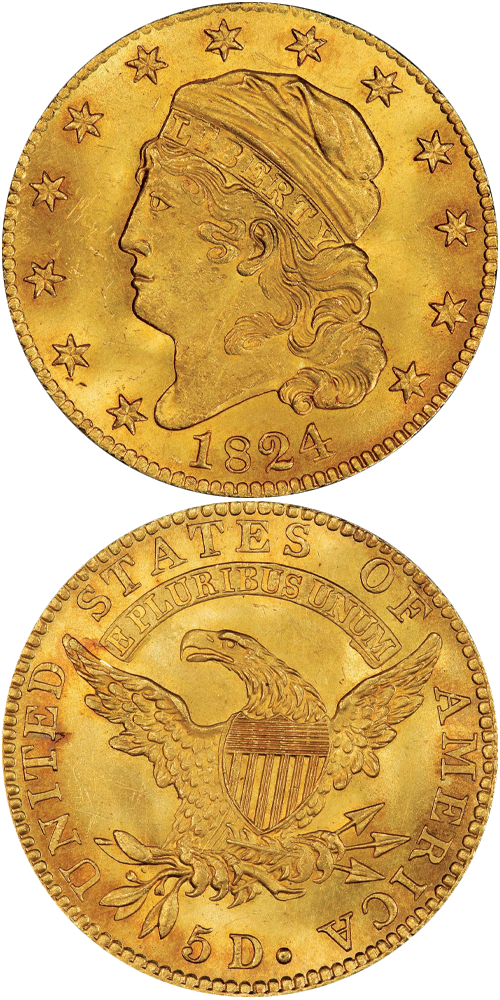1824 Capped Head Left Half Eagle
The half eagles of the 1820s are some of the scarcest of early gold coins as a whole and includes one of the greatest of all American rarities, the 1822 half eagle. By the 1820s, bullion dealers took a special interest in American gold coins due to the mandated legal tender ratio of 15 silver dollars to 1 gold dollar. Gold had risen in price enough that the actual value was roughly 16 to 1. Speculators would buy gold coins at face value using silver then export the coins abroad to be melted down for their intrinsic value, earning the speculator a decent profit. The cycle would repeat over and over enough that the vast majority of all circulating federal gold coin ended up overseas and in crucibles. This speculation ran rampant until 1834 when Congress finally put a stop to it by reducing the weight of the gold denominations and increasing the gold to silver ratio. This effectively made the face value of gold coins higher than the bullion value and encouraging their circulation once more. The 1824 half eagle was not immune to this speculation; out of a total reported mintage of 17,340 pieces, only some 30 to 40 examples remain. Garrett and Guth noted in 2008 that the 1824 $5 appears at auction on average less than one time a year.
The small number of gold deposits at the Mint in Philadelphia in 1824 required only one die marriage of half eagles to keep up with the meager demand. The Mint was very busy with other denominations, striking over a million cents, a half million dimes, and three and a half million half dollars, in addition to smaller numbers of quarters and quarter eagles. The half eagles of 1824 were delivered to the Treasurer of the Mint in three small batches, on May 13, September 7, and November 27. Three coins from each delivery were reserved for inspection by the Assay Commission, while the other 17,340 coins were paid out to depositors and, nearly uniformly, quickly exported. "While gold bullion is in demand at a premium on its standard value, for the purpose of exportation as a remittance," Mint Director Samuel Moore told President James Monroe in his 1824 Annual Report, "no adequate inducement exists to bring it to the Mint, if its value can be otherwise satisfactorily ascertained. It is obvious that, if coined and issued under such circumstances, it cannot be retained in circulation."
Moore's report indicated that half of the gold bullion that was recoined at the Philadelphia Mint came from South America or the West Indies, usually in the form of coins. The other half was composed of 35% raw gold from Africa and 5% native deposits from the mines of North Carolina, while the source of the balance was unknown. Of silver coins, Moore indicated "the principal deposits are made in foreign coins by the banks, especially the Bank of the United States, about $1,200,000 having been received from that institution within the past year." Despite this recoinage, foreign denominations and coins still dominated the commercial interactions of everyday Philadelphians in 1824. Henry Cogswell Knight, a Massachusetts clergyman remarked on his visit to Philadelphia, "Every article goes by fi'p's, so many fi'p's a piece, or dozen." A "fip" or five-penny was local slang for a Spanish-American half real, worth 6-1/4 cents.
The D. Brent Pogue Collection featured an 1824 half eagle that had been paired with an 1823 half eagle for decades, beginning in an Upstate New York collection after the 1943 dispersal of the E.H.R. Green half eagles, then, in succession, the collections of Fred E. Davies, Ted Naftzger, and D. Brent Pogue. Harry Bass, who loved duplicate and triplicate examples almost as much as he loved the first, only ever owned a single 1824 half eagle. Two more are in the National Numismatic Collection at the Smithsonian Institution, a Proof from the Mint Cabinet and a lower grade example from the Josiah K. Lilly Collection.
The example to the left was sold by Stack's Bowers Galleries in the D. Brent Pogue Part IV Auction, where it realized $135,125.






